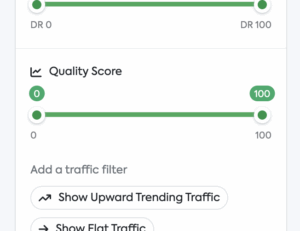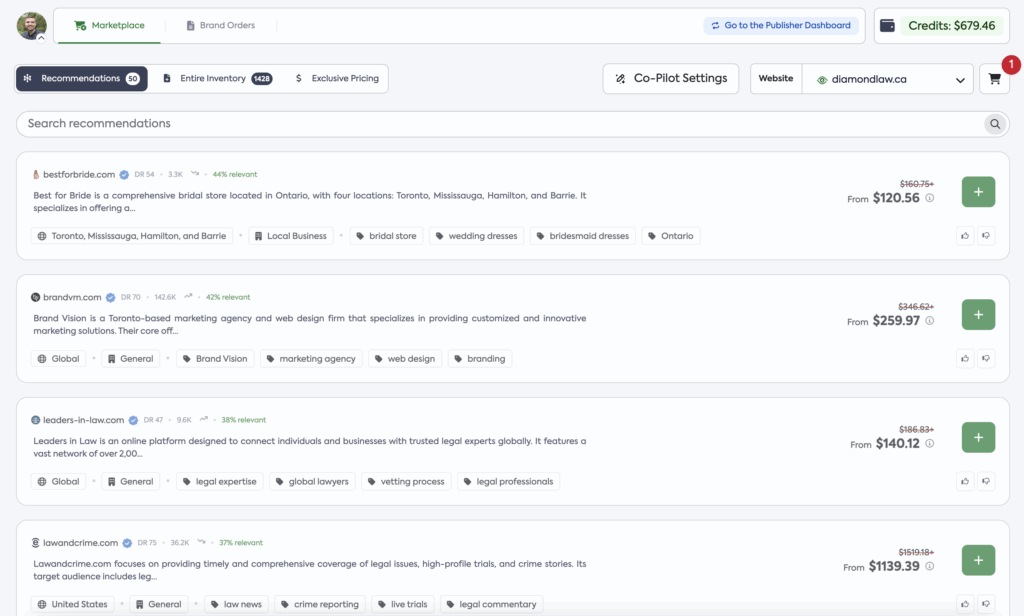Today we’re rolling out Publisher Quality Score (QS) inside the SearchEye marketplace—a new, pragmatic way to evaluate publications before you pitch or place. Agencies have long relied on DA/DR and traffic to sort inventory, but those surface metrics can be inflated, stale, or simply not aligned with what your clients actually need: visibility and trust from real audiences. QS fills that gap by quantifying publisher quality using site-wide signals that map to long-term value, not vanity numbers.

QS is purpose-built for the realities of agency work. You need a standard that’s fast, defensible, and intuitive for stakeholders who don’t live in backlink spreadsheets. You also need a way to keep momentum—moving from discovery to outreach with confidence that your shortlist won’t backfire in three months. QS makes that possible by translating complex signals into a single score you can sort, filter, and report on.
Why agencies need QS now
“Good metrics” can still lead you to mediocre publishers. We’ve all seen sites with respectable authority and traffic that publish generic, off-topic content, hide ownership, or overload readers with low-quality ads. Those placements rarely drive brand-safe exposure or durable SEO value—and they’re hard to defend in client retros.
QS looks beyond magnitude to merit. It captures whether a publisher is building a real business with a clear audience, whether the experience is trustworthy and well maintained, and whether the content itself adds original value. That is ultimately what earns links that compound, mentions that you’re proud to show clients, and coverage that moves the needle.
What QS measures
Content Quality & Relevance. QS examines depth, originality, and topical focus. Publications that consistently publish well-edited, on-topic pieces with clear editorial intent score higher than sites churning out broad, keyword-stuffed posts. If categories feel scattershot or the writing reads like low-effort filler, QS reflects it.
Business Authenticity. Real publishers have a real identity. QS weighs signals like transparent ownership, a coherent mission, credible author bylines, and visible ways to contact the organization. Anonymous “who’s behind this?” sites, or publications that exist primarily to sell links, see lower scores.
Trust & Legitimacy. Beyond what a site says about itself, QS considers how it operates: professional standards, policy disclosures, and patterns that align with earned authority rather than manufactured metrics. Publications that demonstrate editorial integrity and attract credible citations fare better than those propped up by low-quality networks.
User Experience & Design. Readers should be able to navigate, read, and engage without friction. QS reflects clean architecture, sensible ad experiences, readable layouts, and modern responsiveness. Clutter, intrusive monetization, or template bloat are quality drags.
Freshness & Maintenance. Living publications look… alive. QS rewards consistent updates, current information, and signs of active stewardship. Long gaps in publishing, broken elements, or neglected site hygiene pull scores down.
How QS fits your workflow
QS is embedded across the SearchEye marketplace so your team can work faster and safer. As you browse opportunities, every publisher shows a single score you can sort and filter. Set a minimum threshold with the quality slider to enforce standards from the start—no more sifting through low-value options just because they meet a DA target.
Not sure where to set the bar? Tell Co-Pilot your industry, goals, and tolerance for risk. It will recommend sensible QS ranges (especially important for sensitive verticals like finance or health), then surface vetted publications that fit. If you want an extra sanity check on momentum, layer in our optional 12-month trending traffic view—useful for spotting rising outlets that pair strong QS with audience growth.

Reading the score (and setting thresholds)
QS is calibrated for decision-making, not perfectionism. Scores in the 25–40 range often indicate low-quality or network-risk inventory—generally avoid. The 40–70 band covers the broad middle: legitimate publishers that can make sense when relevance, budget, or speed matter. A score of 70+ signals high-quality publications that are ideal for flagship announcements, thought leadership, and marquee contributions.
Many agencies start with a floor of QS 60 for day-to-day outreach and raise to 70+ for priority stories. When a site is hyper-relevant and timely, dipping into the upper-50s can still be a smart trade—QS gives you the context to make that call deliberately.
QS in the wild: two quick examples
Example 1: ecommercefastlane.com (QS ~70+). A focused e-commerce publication with original long-form content and an established podcast. Clear ownership, engaged audience, professional UX, and steady publishing cadence push the score into high-quality territory—great for DTC/Shopify stories that need both credibility and targeted reach.
Example 2: newsofthehour.co.uk (QS ~30s). A generic, catch-all blog spanning unrelated categories with minimal editorial focus. Limited authenticity signals and templated presentation suggest network risk. Despite any passable metrics, QS flags it as low-value for brand-safe placements.
What agencies gain
Defensible quality. QS turns “it looked fine” into a measurable standard. It helps you prioritize fewer, better links that survive algorithm updates and client scrutiny, and it gives account teams a simple narrative—average campaign QS, share of QS 70+, and why certain publishers made (or didn’t make) the cut.
Time saved, risk reduced. With QS and Co-Pilot, you spend more time pitching the right outlets and less time manually vetting the wrong ones. Your outreach list tightens, your acceptance rates improve, and your clients see placements on publishers that build real authority and real audiences.
Get started
Create your SearchEye account and try QS free for two weeks. Set a QS threshold, lean on Co-Pilot for recommendations, and see how a quality-first workflow changes the caliber of your coverage—and the confidence of your reporting.

